Gig economy explained: Pros, cons, future outlook
Everybody knows at least one gig worker—people who drive for Uber or Lyft, deliver food for DoorDash, freelance on Upwork, rent out rooms on Airbnb, or work a combination of jobs to piece an income together. Their employment isn’t exactly stable, but the freedom they have to manage their schedule has some serious appeal.
The “gig economy” is the name for short-term, flexible jobs that use online platforms to connect with clients or customers. It’s a rapidly growing work style that is changing how people work by offering flexibility and extra money at the cost of job security and traditional benefits.
In this article, we’ll talk about the pros and cons of gig work, who thrives in it, how it’s impacting different industries, and what its future looks like.
The pros and cons of gig work
The debut of gig work was exciting. People were clocking out of their salaried jobs to drive night owls around town for a few hundred extra bucks a week. Schedule-wise, it’s hard to think of a better work arrangement than “whatever you feel like,” be it an hour before the gym or working all night during a busy weekend.
Gig work lets workers:
- Set their own schedule
- Balance work and family life
- Work on many different projects
The abundance of different apps also makes finding work easy when a preferred platform doesn’t have jobs. No Uber rides? Look on Lyft. No DoorDash orders? Try GrubHub.
Gig work’s allure is in the ease with which you can get hired and start earning money. No interviews or HR runaround—just open the app and go.
There are challenges with ditching traditional employment, however, such as:
- No health insurance
- No job security
- Unpredictable income
- Fewer legal protections for workers
On top of all that, using an app can make it hard to speak with actual humans when you encounter an issue. For example, Reddit’s Amazon Flex Driver community is full of software and logistical questions from drivers who are still looking for solutions on Amazon’s support system. They turn to each other instead.
Gig workers are also exposed to more legal liability. Uber drivers in California, for example, must purchase their own driver insurance policy and an Uber rideshare endorsement for protection against on-the-job accidental damages, all at their own expense.
Still, some gig workers are fearless of the challenge.
Who thrives in the gig economy?
One reason so many Millenials and Gen Zs went to college was that influential adults told them it was the best path to a good job. This was true at the time—college degree holders could demand stable, higher-paying jobs—but the market demand for college degrees waned as more young people obtained them.
Grads wanted six-figure salaries, but the job market either a) couldn’t afford them, such as with meager small businesses, or b) wouldn’t pay salaries above the market average, such as with austere billion-dollar corporations.
A contingent of newly graduated workers suddenly found themselves overskilled and underemployed. Gig work, which was only supposed to act as Plan B, became a 40-hour-a-week option.
This is why so many backgrounds are represented among gig workers, including:
- Recent graduates
- Stay-at-home parents
- Retirees
- Freelancers
- Independent contractors
Gigs span industries such as food delivery and creative work, all of which benefit from the diverse skill sets of intelligent, motivated people able to set their schedules and strike a deal.
The impact on industries
Like it or not, gig work isn’t going away, at least not anytime soon. The desire for self-direction and independence has convinced many Americans to choose gig work over a regular job, and that’s changing how businesses approach employment and operations.
Two noticeable impacts of the gig economy include the work-from-home model and the use of independent contractors. In practice, these look like:
- Pizza chains using DoorDash to get food to customers, rather than hiring their own drivers
- Freelancers being hired for specialized tasks like graphic design, content writing, and software development
- Gig workers fielding customer service calls, emails, and chats
- Virtual assistants direct calls and answer basic questions rather than sending calls to a place of business
- Retail merchandising is being set up by local gig workers, rather than sending employees to do it
Companies that once booked car and hotel rentals for traveling employees now offer Airbnb and Uber reimbursements instead. Career professionals host elaborate portfolios on freelancer sites like Upwork. There are more temps than full-time employees.
As full-time jobs turn from staples into luxuries, gig work has stepped in to fill increasing gaps.
The future of work
The gig economy is a jackpot for corporations seeking to shield board members and personnel from liability. People who work with a company rather than for them help to offset exposure and employment costs.
Fiscally, hiring freelancers is an attractive option, and that’s probably why the number of freelancers in the US keeps rising.
Employers who use gig economy workers enjoy many benefits, including:
- Lower hiring and recruitment costs: Hiring freelancers and independent contractors from, say, Upwork is a lot faster and easier than hiring a recruiter, buying a recruiting software license, spending months tracking down the right creative for the job, etc.
- Reduced exposure to legal liability: If a contractor damages a customer’s property while performing work requested by a company, the contractor’s insurance carrier is responsible for making the customer whole. Companies may bear some responsibility, but not nearly as much.
- More strategic flexibility: It’s easier to try out new ideas with self-employed gig workers than to hire a whole department. With no long-term contracts in place, any layoffs due to bad strategy can be handled without tarnishing the company’s reputation.
The gig economy will likely only accelerate. Apps like Doordash have already started building aggregator partnerships with smaller delivery driver services. They hope to capitalize on the growing independent work economy.
Worker-owned platforms
Corporations are just some of the ones taking advantage of doing business via mobile apps. Worker co-ops like Ride and The Drivers Cooperative are making inroads by creating worker-owned gig models. While their bottom-up model attracts less outside investment, the 90 percent income share to drivers earns a loyalty that Uber and Lyft can only dream of.
Coupled with the US’s recent union boom, the worker co-op gig could make gig economy jobs a viable career option for more people.
Gig economy predictions and emerging trends
More gig work means more legislation about fair labor practices, as we’re already starting to see in the US.
Minnesota, for example, recently passed a minimum pay rate for rideshare drivers to ensure they receive a living wage. Despite threats from Uber and Lyft that a wage increase would force them out of the state, the rideshare giants are now required by law to give drivers a minimum wage per minute and mile.
Legislators are also targeting junk fees commonly hidden within these digital platforms. California recently banned junk fees by requiring businesses to state exact pricing up front, rather than tack fees on after customers commit to buy. This will likely affect gig businesses such as:
- Airbnbs that add exorbitant cleaning and service fees to rent totals
- Food delivery services that charge extra service fees to subsidize low worker pay
- Essential needs businesses that charge fees and for which there are no alternatives
Aggregators, client services, industry consultants—all of these are trades that will grow along with the gig economy.
How the gig economy is reshaping work perceptions
Job stability—at least of the 90s sitcom variety—is a notion of the past. It was replaced by the hustle culture of the 2010s, where side hustles were the X factor for earning an income limited only by the imagination. It didn’t matter that drop shippers/rise-and-grinders earned little more than their 9-to-5 peers—what mattered was that a full-time job no longer guaranteed prosperity.
The generation that praised taking out big student loans is fading. The universities they championed seem increasingly out of touch with the students they hope to recruit. America is undergoing a shift away from institutions toward the individual.
Gig work, quiet quitting, working simultaneous jobs, and union growth are all indicators that people are taking work into their own hands.
Companies that want to succeed in this shifting landscape will need to be responsive to these needs, and should plan to offer:
- Flexible work options: Flexible hours and remote work opportunities will make it easier for people to work when and where they want, helping to attract and retain top talent.
- Fair pay and benefits: A company’s reputation doesn’t have the same purchase it once did, making upfront pay, good benefits, and a healthy work-life balance the top requirements of most contractors and gig workers.
- Clear communication: It is always important to keep teams on good terms and in the know. Make sure responsibilities and expectations are clear, and be proactive about avoiding misunderstandings with gig workers.
The successful businesses of the future will be those that can match unique skills with unique needs. Talent acquisition teams should advertise their company’s expansive career networks to prospective employees. Relationships offer the closest thing to job stability in contract work.
Benefits services will also take a more significant role as the lack of benefits for gig workers pushes them to obtain healthcare and retirement plans on their own. Having answers for where to find solutions for different needs will set companies apart.
Conclusion
Everybody knows a gig worker. In the years to come, however, more of us will end up as gig workers ourselves. It’s an idea to get cozy with. While the lack of job stability in the gig economy is daunting, it offers opportunities for new relationships and more meaningful work.
There’s something very grassroots about the gig economy. When you call an Uber, you get a driver with a name and a face, whose car could be stocked with water bottles and chewing gum. It’s nice to know who you’re working with; gig work makes that more possible.
More Resources:
Gig economy: Legal and practical considerations for employers
Talent shortage: Addressing the growing gap in the workplace
Gig economy reshaping benefits expectations





